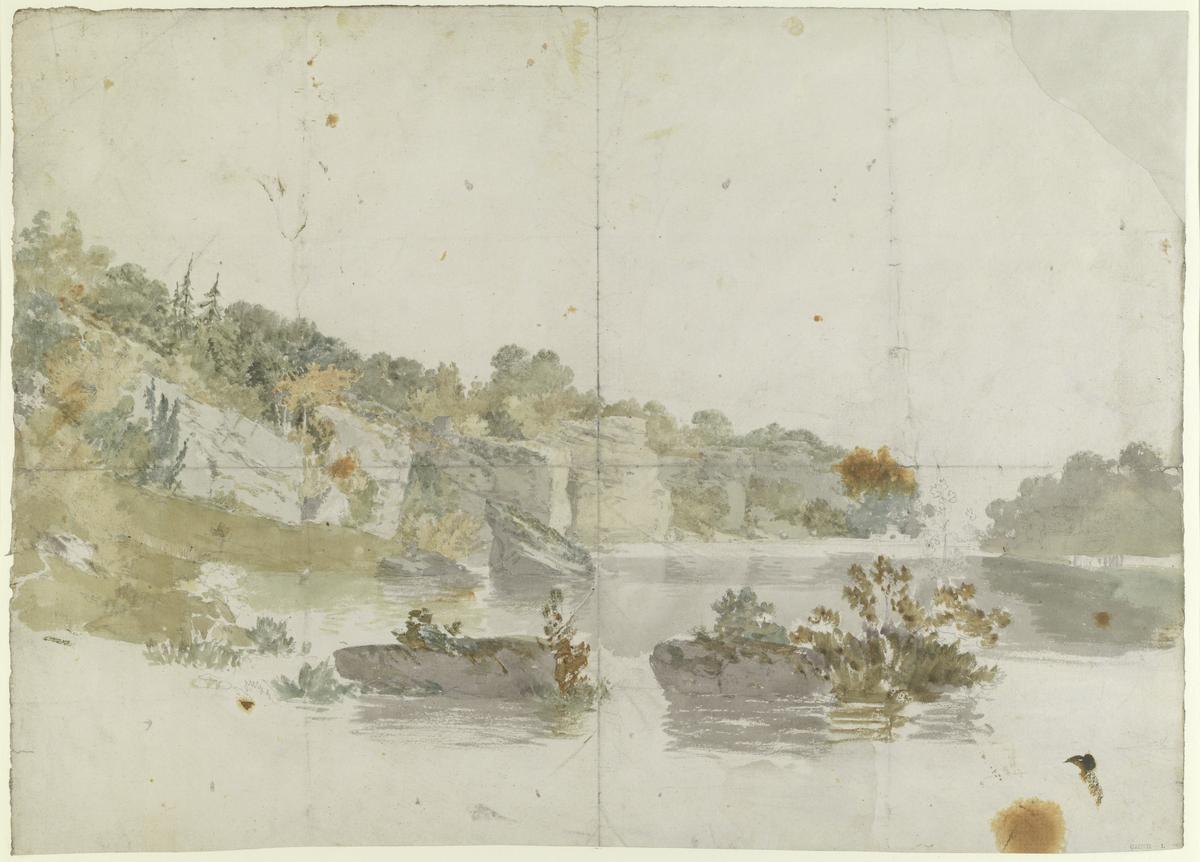Joseph Mallord William Turner Plompton Rocks 1797-8
Joseph Mallord William Turner,
Plompton Rocks
1797-8
Joseph Mallord William Turner 1775–1851
Plompton Rocks 1797–8
D17202
Turner Bequest CXCVII L
Turner Bequest CXCVII L
Pencil with watercolour on white wove paper, 415 x 505 mm
Watermark: fleur-de-lys; countermark ‘IV’
Sttamped in black ‘CXCVII – L’ bottom right
Watermark: fleur-de-lys; countermark ‘IV’
Sttamped in black ‘CXCVII – L’ bottom right
Accepted by the nation as part of the Turner Bequest 1856
Exhibition history
1996
Turner in the North of England, 1797, Tate Gallery, London, October 1996–February 1997, Harewood House, Leeds, March–June 1997 (28).
1990
Turner’s Papers: A Study of the Manufacture, Selection and Use of his Drawing Papers 1787–1820, Tate Gallery, London, October 1990–January 1991 (47, reproduced).
References
1909
A.J. Finberg, A Complete Inventory of the Drawings of the Turner Bequest, London 1909, vol.I, p.602, CXCVII L, as ‘Plumpton Rocks, near Harrogate (?)’. c.1820.
1980
David Hill, Stanley Warburton, Mary Tussey and others, Turner in Yorkshire, exhibition catalogue, York City Art Gallery 1980, p.21.
1984
Martin Butlin and Evelyn Joll, The Paintings of J.M.W. Turner, revised ed., New Haven and London 1984, p.22 under nos.26–27.
1985
David Hill, ‘“A Taste for the Arts”: Turner and the Patronage of Edward Lascelles of Harewood House (I)’, Turner Studies, vol.5, no.1, Summer 1985, pp.32, 45 note 7.
1990
Peter Bower, Turner’s Papers: A Study of the Manufacture, Selection and Use of his Drawing Papers 1787–1820, exhibition catalogue, Tate Gallery, London 1990, pp.107–8 no.47, reproduced.
1996
David Hill, Turner in the North: A Tour through Derbyshire, Yorkshire, Durham, Northumberland, the Scottish Borders, the Lake District, Lancashire and Lincolnshire in the Year 1797, New Haven and London 1996, p.163.
This study is one of two relating to the commission for two views of Plompton Rocks that Turner received from Lord Harewood, probably during his visit to Harewood House in 1797; see also Tate D02392 (Turner Bequest LI Y). The composition is close to that of one of the resulting paintings (private collection),1 being a fairly complete rendering of the view shown there, looking south from the head of the artificial lake towards the dam. Turner’s watercolour washes convey with great sensitivity the atmosphere of the scene. As David Hill suggests, the colour may have been added to provide Lord Harewood with a more complete idea of what his pictures would look like, and the fact that this sheet, much larger than the other, or indeed than any of the Harewood sketches, has been neatly folded into regular rectangles may indicate that it was sent by post from London for his approval. The condition of the sheet indicates that the drawing was also made much use of in the studio.
Despite the refinement of the watercolour washes here, the paintings themselves, as Butlin and Joll note, adopt a coarse handling that probably owes much to the example of Richard Wilson (1713–1782), who influenced other work of this period, notably Morning amongst the Coniston Fells, Cumberland, shown at the Royal Academy in 1798 (Tate N00461);2 see the Tweed and Lakes sketchbook (Tate D01059; Turner Bequest XXXV 57). John Gage3 argues that the coarseness of the paint relates specifically to the fact that the pictures were intended to be read at a distance. Butlin and Joll and Hill, again following Gage, argue that the pink hues of the clouds were introduced by Turner to complement the colour scheme of Adam’s Saloon. This may be so, but it is worth pointing out that several of his Wilson-inspired works of this period use a similar palette; for example Dunstanborough Castle, in the Dunedin Public Art Gallery, New Zealand.4
Technical notes:
As discussed above, the sheet was once folded into eight; it is oil-stained, and the top right corner is missing and has been made good with similar paper.
Verso:
Blank; colour trials; stained and dirty; not stamped.
Andrew Wilton
January 2013
How to cite
Andrew Wilton, ‘Plompton Rocks 1797–8 by Joseph Mallord William Turner’, catalogue entry, January 2013, in David Blayney Brown (ed.), J.M.W. Turner: Sketchbooks, Drawings and Watercolours, Tate Research Publication, November 2014, https://www

